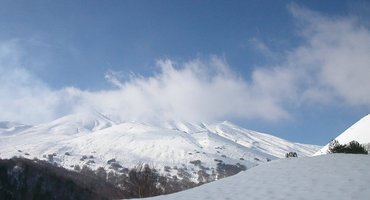
The rocky isle of Sicily rises from the Mediterranean like a giant pebble kicked by the toe of Italy, a land mass the size of Vermont dominated by an active volcano: Mount Etna.


Fresh snow covered Etna's slopes well below the timberline during my visit last week.
At 11,000 feet, Etna would tower over Mount St. Helens (8,400 feet since its explosive eruption 25 years ago). Steam pours constantly from the craters at Etna's summit; lava flows periodically from fissures along its flanks. Its snow-covered cap gives way to a ring of dense forests, then to amazingly fertile hillsides, and, on Etna's eastern slopes, just ten miles from the summit, to Mediterranean beaches.
Etna in a literal and primeval sense dominates this island; one out of every five Sicilians lives on its slopes and feels its presence with every breath and every step. They do not fear it; they respect it. (And no, they don't sacrifice virgins to appease its wrath; local virgins have to look elsewhere for employment.)
A consortium of Etna's many tourist-oriented villages invited me to attend a travel workshop called BuyEtna in the province of Catania last week. A long way to go for a three day visit, leaving Wednesday before dawn (flying from Seattle to JFK to Milan to Catania), returning late Sunday night. I actually spent more time in transit than I did at my destination.
Turns out, the difficulty of reaching Sicily was at least part of the point: the conference organizer wanted to showcase a plan to build a new intercontinental airport in Etna's shadow, replacing the aging Fontanarossa with a facility that would accommodate jumbo jets from America and Asia. Coupled with a controversial, $4.5 billion suspension bridge across the Straits of Messina, a fancy new airport could turn Etna from a remote outpost into the gateway to southern Italy.

A helicopter tour dramatized the volcano's proximity to Sicily's beachfront resorts.
A new airport would also give fresh impetus to the embattled bridge project, under fire for escalating costs, concerns over environmental degradation and (no surprise here) political corruption.
It will take years to resolve the problems. Meanwhile, the volcano lives on, with new fractures and fresh craters erupting occasionally from its flanks, gushing lava every couple of years. At higher altitudes, snowfall makes it all look pristine; further down, bright yellow Etna broom, spiky pulvino thorns and purple-flowering milk vetch eventually take hold, breaking down the lava, encouraging new growth, and giving further evidence of Etna's permanent and immutable power.
Link to Etna webcams: click here.
More on my visit to Mount Etna, and the food, wine and culture of Sicily, coming up later this week.
Posted by Ronald Holden at December 19, 2005 6:11 PM

The International Kitchen
Cooking school vacations in Italy, France & Spain.


 Who links to me?
Who links to me?